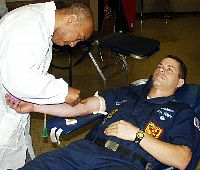
The Source for Navy News
A Call for Blood Platelet Donations
Story Number: NNS031010-08
Release Date: 10/10/2003 12:34:00 PM
![]()
By Lt. John Schofield, Bureau of Medicine and Surgery Public Affairs
WASHINGTON (NNS) -- The aftermath of the Sept. 11 attacks saw a surge of blood donations across the United States. According to the Red Cross, nearly 300,000 units of blood were collected in the first days after the attacks. In fact, the momentum of donations grew so substantially that would-be donors were eventually turned away because of the logistical strain on collection centers. As the Sept. 11 anniversary passed last month, people again flocked to their local donation centers to give blood.
There is another option available equally critical to lifesaving efforts as giving a pint of blood, Apheresis platelet donation.
Platelets are essentially the “sticky” cell-like particles in the blood that act as the building blocks of clotting to control bleeding. They are a critical element of the blood, which is made up of red blood cells, white blood cells, plasma and platelets.
“The process of Apheresis draws the platelets directly from the donor’s blood stream using prepackaged disposable sterile bags,” said Cmdr. Michael Libby, director of the Navy Blood Program at the Bureau of Medicine and Surgery. “The platelets are separated by centrifugation into a collection bag while the plasma, red cells, and white cells are returned to the donor.”
Platelets from a single donor are transfused to a needy patient. Giving a pint of blood benefits those patients needing platelets as well, but it takes almost eight donors of whole blood to equal one Apheresis-prepared unit of platelets. That is why a platelet donation is so valuable.
Platelets are particularly essential to patients suffering from various cancers and undergoing chemotherapy, as well as bone marrow transplant recipients, because these patients cannot make their own platelets in adequate amounts during treatments.
There is always a shortage of platelet units at military treatment facilities (MTF). A regular blood donation has a shelf life of almost a month; platelets must be used within five days.
If you can donate blood, you can donate platelets. Pre-donation interviews and screenings are conducted just like regular blood donations, but the process is slightly longer. It takes approximately two hours to donate platelets compared to one hour usually needed for blood donation.
Approximately 18 percent of the donor’s platelet amount is removed, leaving the donor with a more than adequate complement left in the blood stream. There are essentially no new risks in platelet donation compared to those encountered during a whole blood donation.
Platelet donors are needed because there is no substitute. Just as blood donors in the wake of Sept. 11 made a difference, you can make a difference today by donating platelets at your MTF donor center.
For related news, visit the Navy Medicine Navy NewsStand page at www.news.navy.mil/local/mednews.
E-mail this story to a friend | Send a comment about this story
|
All Any Exact |
|
